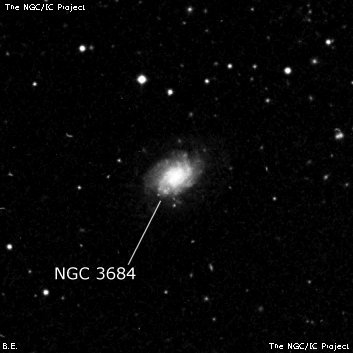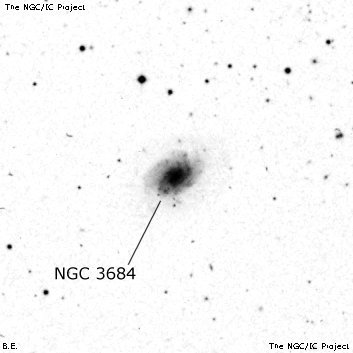NGC/IC Project Restoration Effort
(This is a very very beta version)
NGC3684


Basic Information
Location and Magnitude
Right Ascension: 11:27:11.1
Declination: +17:1:51
Constellation: LEO
Visual Magnitude: 11.4
Historic Information
Discoverer: Herschel W.
Year of discovery: 1784
Discovery aperture: 18.7
Observational
Summary description: pB, pL, E, vgbM
Sub-type: Sbc
Corwin's Notes
=====
NGC 3684 may be H II 160. Wolfgang Steinicke has recently (2013) suggested
that WH's sweeps over this area only partially overlapped, so that he (WH)
could not have seen N3686 in the second of them (sweep 198 on 17 April 1784).
Therefore, Dreyer's suggestion that N3686 = III 28 is also H II 160, is
probably incorrect.
The equivalence with N3686 makes sense, however, given that the reduced
position from WH's observation is just 1 minute of time more and at the same
declination -- within the errors -- as the position for N3686. The difference
for N3684 is half a minute of time, and 10 minutes of arc. A mistaken reading
of a single minute of time seems more likely than errors in both RA and Dec,
but the two errors are what Wolfgang is suggesting.
Looking at CH's fair copies of the sweeps, I do not see information that can
help determine the path of the telescope on the sky, so cannot reproduce
Wolfgang's argument. The information may be in other of the Herschel Archive
files that I haven't examined yet. In particular, there is a large section
with CH's work on her brother's observations that may be quite helpful in
circumstances like these.
I have, however, re-reduced the observation of WH's nebula with all three
stars that he observed in the sweep (81, 85, and 90 Leonis), and the positions
are coincident to within WH's known errors. The problem therefore is
certainly in the observation of the nebula itself. I also see in the fair
copy that the nebula is the only one for which the time is recorded with
minutes and seconds rather than minutes and decimals. Was there something
special about this observation that WH has not told us? His full description,
by the way, reads, "cL, R, brightest in the M, but the brightness goes off
very gradually." This description could apply to either galaxy.
A not-so-by-the-way: There is no problem with the NGC identifications of
these two objects. JH adopted his own pretty good positions for them in GC,
and Dreyer adopted very similar positions for the NGC. Only the WH number,
II 160, may be wrong on the galaxies.
Steve's Notes
=====
NGC 3684
13.1" (1/18/85): moderately bright, slightly elongated NW-SE, broad concentration. Second of three on a line with NGC 3681 14' SW and NGC 3686 14' NE. Also, NGC 3691 lies 15' SE.



